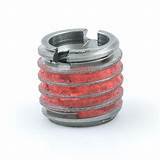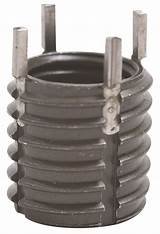-
Welcome back Guest! Did you know you can mentor other members here at H-M? If not, please check out our Relaunch of Hobby Machinist Mentoring Program!
You are using an out of date browser. It may not display this or other websites correctly.
You should upgrade or use an alternative browser.
You should upgrade or use an alternative browser.
+1 for keeping the bolts matching the originals if at all possible. I used Imperial socket head capscrews on the carriage stop of my lathe because I keep a lot of them on hand for model airplane use. Now I need 2 Imperial hex wrenches on an otherwise 100% metric lathe. Dumb move on my part.
- Joined
- Mar 26, 2018
- Messages
- 8,407
I Agree,Another vote for Helicoil.
If you have not used these before, now is the time. This is the right thing to do for this kind of fix. They're easy and strong.
When no other option is available, a properly installed helicoil works very well.
We used them at times at the shop. Never had a problem with them that I remember.
I have a set of 4 metric (I believe) bolts that have stripped the threads out of a diesel engine thermostat housing they were bolted into. The reason for the stripping was because the previous owner had used the wrong threaded replacement bolts which ruined the threads so it is not a mechanical fault. I need to drill out the stripped threads and tap the holes to fit a new set of bolts that are just big enough to facilitate this.
Heli-coil is my go to for that sort of thing.
Major diameter of the current bolt threads measure 0.235" on my calipers. Shaft diameter measures 0.237"
So probably 6mm? What engine is it?
Clearance is small so I need to be drilling out the least amount possible to keep the strength of the thermostat housing intact.
Again, heli-coil. It's the smallest amount to cut away that you'll find. Others use the same "STI" tap for the inserts, but they need counterbores, or other fancy space occupying shenanigans.
I have done drilling and tapping before but It has been so long that I wanted to ask before cutting away my one likely chance at correctly re-threading and therefore saving my engine.
Good call. It's tough to undrill a hole.
Current bolts are 3.63" long including the cap. but threads are only 0.87" Original bolts were threaded all the way up the shaft to the cap however.
So 80? 85? millimeters nominal? That's an odd size that raises a flag. Not a bad flag, more like an informational flag. If it's purely for reach, you'd more likely see the normally threaded bolt. If the OE chose a bolt for an application like that, which was threaded all the way... There's probably a reason. Are you positive that those are OE, or could this have been serviced multiple times?
I need help figuring out the following information:
1. New thread diameter and pitch to source new bolts and taps
Heli coil kits cut a thread that is not a normal thread size, then you screw in the insert. They are sold based on the thread diameter that you are "fixing", not on what they actually cut. The tap will come in the kit.
2. New tap pilot drill bit size that will create a smooth wall out of the stripped threads
The tap drill will also come in the kit.
3. Clearance fit drill size that the new bolts will comfortably fit through.
Not needed, you would still be using the original nominal bolt dimension.
SAE or Metric are both fine, the correct size and being able to find quality bolts, drills, and taps are what is important.
Go with OE. If it's a metric engine, stay with it. If it's an "inch" engine, stay with it. That is the stuff nightmares are made of.
If anyone knows what high grade of bolt I should use for a rumbling diesel engine and a good place to source them along with taps and drills that would be great as well.
For that application, I'd guess you're probably looking at "normal" stuff. 8.8 or 10.9 if it's metric, and almost universally grade five in inches. What was the OE? Do you have absolutely known original bolts available to you? The head will be marked. Does the OE still support this engine? If you could buy four "mystery" bolts, which have the potential to total the engine if they fail... Ten bucks each (forty bucks) is 37 dollars more than hardware grade stuff. That thirty seven bucks might be the cheapest peace of mind you could come by...
Any help with this situation will be much appreciated!
Thank you!
The best help would be if we knew what the engine was. Somebody here is bound to recognize it. One key factor for 100 percent sure is to CONCRETELY NAIL DOWN exactly what size bolt you originally had. You have described the current bolts as (apparently) being 6mm. Myself, and (apparently) this forum believe you have a 6mm bolt. But things are clearly not right inside of there. Is that an "inch" engine? Is it a metric engine that used a different thread pitch? Is there a previous repair in there that failed so the hole can't be properly qualified anymore? All those questions are on the table until they're satisfied.
We'll still need to know for sure if these holes go into a water jacket. If they're blind holes, it's easy. If they go inside to where the water is, the repair stays the same, but there's extra steps, and setup/wait time involved, and (possibly) some "belt and suspenders" items that are prudent to take. (99 times out of 99 times, "belt and suspenders" add ons are garbage and should be skipped. But "sometimes" they have a place......
The other issue is thread engagement. The actual length of thread that's engaged in the (block? head? intake?) when you bolt this together. That "fully threaded bolt" thing sends off tingles that this "may" lead to an important detail. Or it may be nothing....
The heli-coils that I (and others) recommended get a lot of hate on the internet, but in practice, they make stronger joints than most of their counterparts in cast metals (other applications differ), they're dirt simple, they're VERY forgiving of freehand metal working (you'gotta be good still, but "perfect" can be relative with these... 30 years in truck and equipment repair. These make stout reliable repairs on structural things, and million mile repairs on truck engines.
There are many brands of these, Heli Coil is the "kleenex", they've been out so long that the name is almost universal. They're good. "Save a Thread" is very common at the DIY parts stores. Those are good. McMaster has had a couple of brands, they're good. Stuff off of Amazon or Ebay.... Buyer beware. Part of the magic is quality control in making the "coils". Discounted products tend to lack heavily in that department, and you don't want a Heli Coil that is made of cheese.
What's the engine? Or make/model/year if that applies. Or the application? Pictures?
- Joined
- Dec 23, 2012
- Messages
- 771
Sounds like fun project. To bad live my town.I have a set of 4 metric (I believe) bolts that have stripped the threads out of a diesel engine thermostat housing they were bolted into. The reason for the stripping was because the previous owner had used the wrong threaded replacement bolts which ruined the threads so it is not a mechanical fault. I need to drill out the stripped threads and tap the holes to fit a new set of bolts that are just big enough to facilitate this.
Major diameter of the current bolt threads measure 0.235" on my calipers. Shaft diameter measures 0.237"
Clearance is small so I need to be drilling out the least amount possible to keep the strength of the thermostat housing intact. I have done drilling and tapping before but It has been so long that I wanted to ask before cutting away my one likely chance at correctly re-threading and therefore saving my engine.
Current bolts are 3.63" long including the cap. but threads are only 0.87" Original bolts were threaded all the way up the shaft to the cap however.
I need help figuring out the following information:
1. New thread diameter and pitch to source new bolts and taps
2. New tap pilot drill bit size that will create a smooth wall out of the stripped threads
3. Clearance fit drill size that the new bolts will comfortably fit through.
SAE or Metric are both fine, the correct size and being able to find quality bolts, drills, and taps are what is important.
If anyone knows what high grade of bolt I should use for a rumbling diesel engine and a good place to source them along with taps and drills that would be great as well.
Any help with this situation will be much appreciated!
Thank you!
I have done a lot over years.
The way found the stayed was to either use nect size bigger or thread and a larger thread using Loctite and re-tapping the hole.
Or this witch could easier depend condition will cost more

====≈=======================
They make a thread insert looks
like spring

AkA Helical coil type
DO NOT USE THIS TYPE THEY WILL FAIL.
Now you have more work to do.
Dave
- Joined
- May 7, 2023
- Messages
- 1,347
I prefer keenserts/timeserts, but for some applications there just isn’t enough meat to install them.You tube has some other comparisons.
- Joined
- Dec 23, 2012
- Messages
- 771
I only use a blank then drill and tap orI prefer keenserts/timeserts, but for some applications there just isn’t enough meat to install them.
McMaster-Carr
McMaster-Carr is the complete source for your plant with over 595,000 products. 98% of products ordered ship from stock and deliver same or next day.
Thd Helical coil type I have had to replace.
Dave

